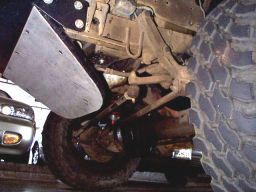|
|
|


The steering stabilizer sits low behind the front axle as part of the drag link, making itself an easy target for rocks. The lower image shows a slightly bent stabilizer. Images courtesy of Ho Chung, enhanced. (Note: this vehicle is far from stock, although the steering mechanism is. Don't panic if your Disco doesn't look like this :-) |
The Disco II stabilizer is "Defender style", sitting high near the Panhard rod. The rod behind the axle is a plain tube. While not as low-hanging as the DI stabilizer, the link still feels vulnerable. An RX "pre-bent" link would help. A Southdown-style skid plate should put the issue to rest once and for all. |

The original Discovery employs a locking center diff with a shifter of five positions (4H, 4L, 4H lock, 4L lock, neutral). Photo courtesy of Ho Chung. |

Disco II adopts the ETC (electronic traction control) technology and the lock on the center diff is no longer available. The transfer case shifter is simplified to 3 positions (H, L, and N) instead of 5. What's curious is that the diff can still be locked, but it's "for service purposes only" (right, we all go off-road for service). There is a warning light on the dash which turns on when the diff is locked. So, there is still a locking diff underneath, just minus the shifting mechanism. (p.s. Some lr-discovery list members have posted that they've been told by the dealer that the center diff lock IS still there. The lock can be engaged with a wrench from under the transfer case. This helps you to limp home in 2WD when a halfshaft is broken.) |


The Discovery uses an A-frame rear suspension similar to the orginal range rover (and the new Grand Cherokee WJ - see picture). Photo courtesy of Ho Chung. |
Disco II replaces the A-arm with a Watts linkage for better lateral control of the axle. This contributes to better handling on the highway. Also, Disco II posts better wheel travel numbers than the original Discovery. |
|
Front shaft, axle side Front shaft, T-case side The original discovery uses the following joints:
|
Rear shaft, T-case side Rear shaft, axle side The Discovery Series II uses the following joints:
|
|
|